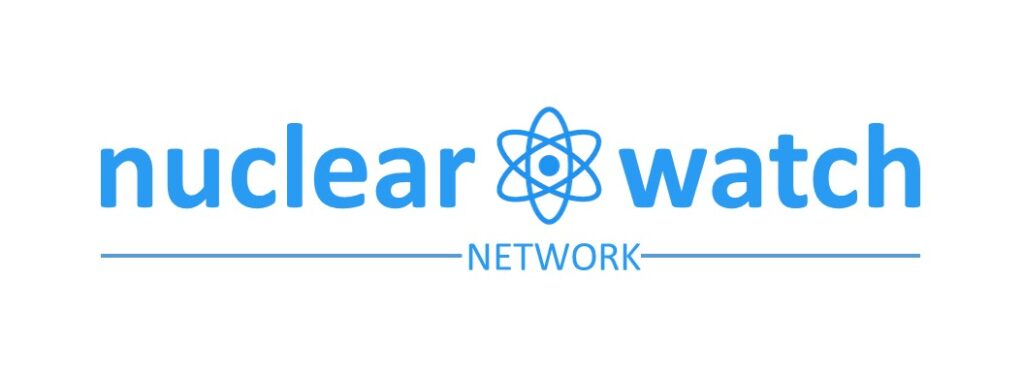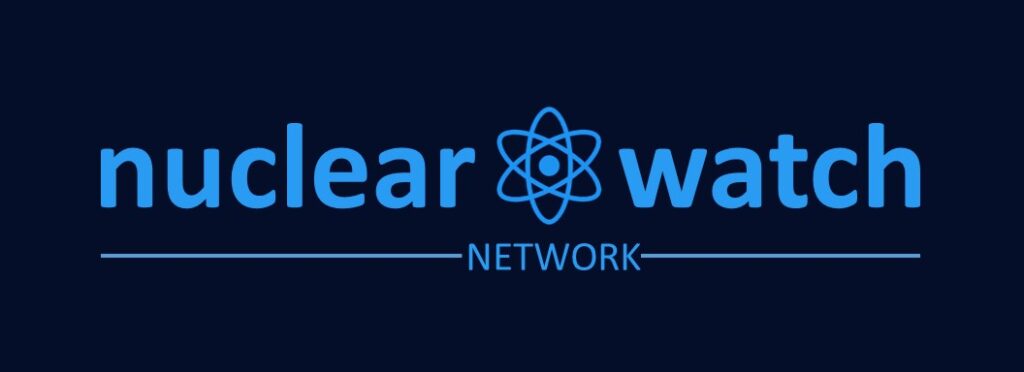The Israeli regime has long employed a policy of neither confirming nor denying its nuclear program in the international community. However, there is growing evidence to suggest the potential possession and use of nuclear weapons, including statements by Israel’s Minister of Heritage in November 2023, who hinted at the option of a nuclear strike on Gaza—an utterance that led to his suspension from cabinet meetings by Netanyahu[1] [2]. Additionally, there are reports of the possible use of small tactical nuclear weapons in Tartus, Syria, in the days preceding[3], as well as the publication of numerous articles and reports from institutions such as SIPRI[4], NTI[5], FAS[6], CNPS[7], and others that provide further corroboration of Israel’s possession of nuclear weapons.
The occupying regime of Palestinian territories has had nuclear weapons since the 1960s, yet it accuses Iran of seeking to acquire nuclear weapons. According to the religious principles of Islam, the development and use of any weapons of mass destruction is prohibited (haram), and therefore, Iran has never sought to build nuclear weapons, nor does it intend to do so in the future. The Israeli regime is the only regime in the region that possesses such weapons and is also accused of having used them in Syria.
The ideology of Benjamin Netanyahu, the Prime Minister of the Israeli regime, aims to establish a Greater Israel that extend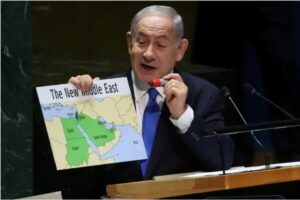 s from the Nile River in parts of Egypt to the Euphrates River in parts of Iraq. In his speech at the United Nations General Assembly in September 2023, he presented a new map of the Middle East, which reflected part of his ideology of achieving a Greater Israel[8]. Today, approximately 70% of The Golan Heights in Syrian territory is under the control of this regime[9], with the Euphrates River flowing through Syria as well.
s from the Nile River in parts of Egypt to the Euphrates River in parts of Iraq. In his speech at the United Nations General Assembly in September 2023, he presented a new map of the Middle East, which reflected part of his ideology of achieving a Greater Israel[8]. Today, approximately 70% of The Golan Heights in Syrian territory is under the control of this regime[9], with the Euphrates River flowing through Syria as well.
This vision also encompasses parts of Saudi Arabia, which could serve as a warning for the leaders of this country. The United States, through its financial, military, and political support for this regime, and by promoting the Abraham Accords to normalize relations between Arab countries and the Israeli regime, seeks to implement the ideology of global Jewish expansion through this regime. The countries in the region must be aware of this ideology and resist normalizing relations with this occupying regime. This regime utilizes every lever, including nuclear weapons, and relies on U.S. political support for the use of such weapons, to advance the goals of its ideology of spreading Judaism worldwide.
The reckless actions of the Israeli regime, including threats of a nuclear attack on Gaza, the ideology of a Greater Israel, uncontrolled attacks on regional territories such as Syria and Yemen, threats to attack Iran’s nuclear facilities, brutal assassination attempts against scientists from various countries including Iran, Syria, and Iraq, and the experience of attacking Iraq’s and Syria’s nuclear facilities, will contribute to the formation and acceleration of an arms race, particularly nuclear, in the region. The international community, rather than focusing on Iran’s entirely peaceful nuclear program, which is being implemented under the strictest monitoring of the International Atomic Energy Agency (IAEA) and in compliance with the latest global nuclear safety standards, should be more concerned with the nuclear proliferation threats posed by Israel. These threats aim to prevent the instability consequences in the region and ensure non-proliferation.
It is the Israeli regime that has closed the doors of IAEA and international oversight to its nuclear sites, including Dimona and other suspected sites for the development of nuclear weapons, while expanding its own nuclear deterrence capabilities. Instead of focusing on the discourse of moving towards nuclear weapons should Iran acquire such technology, countries like Saudi Arabia, Turkey, and Egypt should be more concerned about their own survival in the face of a potential nuclear and military attack by Israel, driven by the ideology of a Greater Israel.
Israel regime has never signed the Nuclear Non-Proliferation Treaty (NPT) and has a highly secretive nuclear program. Reports indicate that in the 1960s, the United States supplied Israel with approximately 300 kilograms of highly enriched uranium[10]. Estimates suggest that Israel possesses approximately 90 plutonium-based nuclear warheads, and it is predicted that its plutonium stockpile is sufficient to produce between 100 to 200 nuclear warheads.
Sites suspected of being linked to nuclear weapons programs
The Negev Nuclear Research Center, located near the city of Dimona in the southern part of the occupied territories, is considered the first facility of the Israeli regime’s nuclear program. Established with the help of the French in the late 1950s and early 1960s, this facility is suspected of being involved in the development of the regime’s nuclear weapons. It is believed that the center produces the critical fissile material necessary for nuclear bomb production, namely plutonium. Dimona has been the subject of numerous reports and investigations, but the Israeli regime has maintained a policy of ambiguity and does not allow international inspectors to monitor the site. The facility houses a heavy-water reactor, which is officially defined as being for research purposes but was actually established with the goal of producing plutonium for the development of the regime’s nuclear weapons.
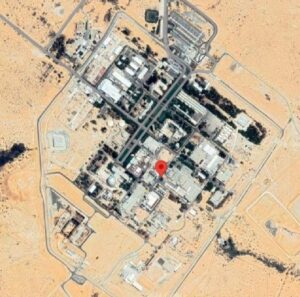
According to reports, Eilabun is recognized as the second weapons storage facility for the Israeli regime, where it is believed that various types of military equipment, including tactical nuclear weapons and landmines, are stored. Located in the northern part of the occupied territories, this facility is part of Israel’s secretive and extensive network of military and nuclear sites. While specific information about the site remains unavailable due to Israel’s policy of ambiguity and nuclear denial, Eilabun is suspected of housing a range of nuclear and conventional weapons, including tactical nuclear weapons designed for battlefield use. These weapons, which have lower yields or explosive power than strategic nuclear weapons, are intended for regional and localized conflicts. Like other sites implicated in advancing the regime’s nuclear program, Eilabun is off-limits for international inspections, and the regime has never officially confirmed the existence of such a site or the presence of nuclear weapons there. The secrecy surrounding this facility aligns with Israel’s strategy of nuclear denial and ambiguity. It is important to note that information about this site comes from various unofficial sources, as Israel’s nuclear program remains highly classified.
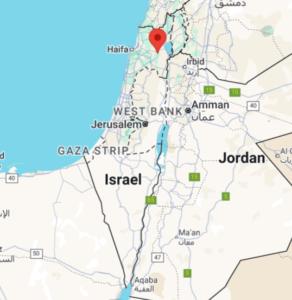
Kfar Zekharia is another location in the occupied territories where there has been speculation about its role in the Israeli regime’s nuclear weapons program. While the regime has never officially confirmed the details of its nuclear infrastructure, this site is often cited in unofficial reports as a nuclear missile base and bomb storage facility. Like other sites of this regime, Kfar Zekharia is considered vital for supporting Israel’s deterrence strategy, and it likely serves as a secondary legitimate tool for retaliation in the event the regime’s existence is threatened. Despite the policy of ambiguity regarding the possession of nuclear weapons, the secrecy and covert nature of Israel’s nuclear infrastructure are believed to play a key role in deterring its enemies.
Nahal Soreq, or the Soreq Nuclear Research Center, is a significant nuclear research facility in Israel. Located near the coastal city of Yavne, south of Tel Aviv, this center is subject to monitoring by the International Atomic Energy Agency (IAEA), although these inspections face certain limitations. Despite Israel’s official denial of any nuclear weapons development activities at this facility, the Atomic Archive website[11] suggests that the center contains laboratories at the level of those found in U.S. national weapons facilities, dedicated to research, design, and construction of weapons. Many experts believe that this center is linked to the regime’s nuclear deterrence strategy. Like other nuclear sites in Israel, Nahal Soreq is highly secured due to its sensitive nature, and details about nuclear weapons development activities at this center remain unavailable. Nonetheless, the regime continues to maintain its policy of neither confirming nor denying the possession of nuclear weapons.
Yodfat is another suspected site involved in the Israeli regime’s nuclear weapons development, located in the northern part of the occupied territories. There is limited information available about this site and its activities. While its existence has not been officially confirmed by the Israeli regime, the confirmation and limited details about it are based on information and speculations from international non-proliferation sources. Although the specific activities at the site are unclear, it is believed to be involved in the assembly of nuclear weapons. Some reports suggest that this site is used for the final stages of nuclear weapons assembly or as a storage location for nuclear materials related to weapons development. Like other sites in this regime, Yodfat is highly secured, and Israel’s policy of neither confirming nor denying its possession of nuclear weapons has contributed to the expansion and development of its nuclear infrastructure. Efforts to gain intelligence on the regime’s nuclear activities are thus largely limited to speculation.
Tirosh is another suspected facility for the storage of nuclear weapons in the occupied territories, located between the cities of Beit Shemesh and Kiryat Malachi. Like other sites of this regime, its existence or non-existence has not been officially confirmed. Many believe that this site is part of the infrastructure for the regime’s nuclear deterrence program, where strategic nuclear weapons are stored. Alongside the Eilabun site, which is suspected of storing the regime’s tactical nuclear weapons, Tirosh is believed to store strategic nuclear weapons, which are intended to target key strategic positions in major conflicts.
Rafael Advanced Defense Systems, an Israeli contractor, is known for the construction and development of a wide range of advanced military systems, including defense missile systems, air defense systems, and precision-guided munitions. While the company is primarily recognized for its work on systems such as the Iron Dome and David’s Sling, it is also linked to the regime’s nuclear weapons program, particularly in the areas of assembly and weapon production. Although the company’s collaboration with Israel’s nuclear program has not been officially confirmed, there is speculation about its role in the assembly of the regime’s nuclear weapons. While other sites, such as Dimona (the Negev Nuclear Research Center), are known as nuclear production and research facilities, which were first exposed in a 1960 article in a Time[12] magazine article, Rafael is alleged to be involved in the later stages of nuclear weapons production, especially in converting nuclear materials into warheads for missiles. Given the high level of security surrounding the regime’s policy of ambiguity and secrecy regarding nuclear activities, the exact role of this company in the regime’s nuclear program remains unclear. Some reports and analyses suggest that Rafael is involved in the construction of nuclear warheads and ensuring their functionality during use.
Conclusion
Contrary to Iran’s continuous international efforts to build a world free of nuclear weapons, including initiatives to create a Middle East nuclear-weapon-free zone agreement within the United Nations and the International Atomic Energy Agency, the Israeli regime is seeking to develop its deterrence policy through nuclear weapons. The International Atomic Energy Agency, based on its statute and inherent duty as the nuclear watchdog of the United Nations in the pursuit of disarmament and non-proliferation of nuclear weapons, must continue its efforts to reach and secure the acceptance of an appropriate agreement by the countries of the Middle East for the implementation of the nuclear-weapon-free zone idea and compel Israel to fully comply with the safeguards agreement and join the Treaty on the Non-Proliferation of Nuclear Weapons.
[1] https://www.theguardian.com/world/2023/nov/05/netanyahu-reprimands-israeli-minister-over-gaza-nuclear-option-comment.
[2] https://www.aa.com.tr/en/middle-east/israeli-minister-renews-call-for-striking-gaza-with-nuclear-bomb-/3117351.
[3] https://www.india.com/news/did-israel-explode-a-small-nuclear-bomb-in-syria-spike-in-radiation-report-says-7490316/.
[4] https://www.sipri.org/media/press-release/2024/role-nuclear-weapons-grows-geopolitical-relations-deteriorate-new-sipri-yearbook-out-now
[5] https://www.nti.org/countries/israel/
[6] https://fas.org/publication-term/israel/
[7] https://armscontrolcenter.org/countries/israel/
[8] https://www.timesofisrael.com/liveblog_entry/netanyahu-brandishes-map-of-israel-that-includes-west-bank-and-gaza-at-un-speech/
[9] https://www.aljazeera.com/news/2024/7/29/what-is-the-golan-heights-and-who-controls-it
[10] https://fissilematerials.org/countries/israel.html
[11] https://www.atomicarchive.com/almanac/facilities/israeli-facilities.html
[12] “The Atom: The Nth Power”. Time. December 19, 1960. Archived from the original on May 29, 2010. Retrieved July 2, 2007.
